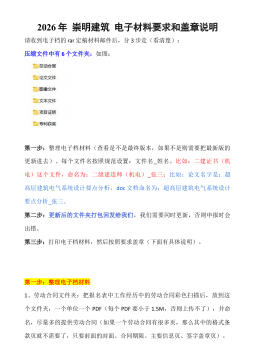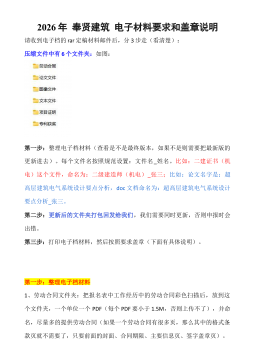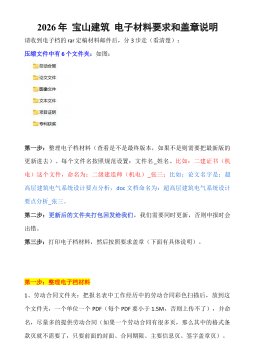美国总统就职演说的体裁分析
VIP免费
CONTENTS
Acknowledgements
Abstract
中文摘要
Chapter 1 Introduction ................................................................................................1
Chapter 2 Genre and Genre Analysis .........................................................................4
2.1 On genre ...............................................................................................................4
2.1.1 An overview of genre .................................................................................4
2.1.2 The definition of genre ...............................................................................5
2.1.3 Discourse community ................................................................................ 6
2.2 On genre analysis ................................................................................................. 7
2.2.1 The concept of genre analysis ....................................................................7
2.2.2 Constructing the audience ..........................................................................7
2.2.3 Advantages of generic analysis .................................................................. 8
2.3 Genre and English for Specific Purposes (ESP) .................................................. 8
Chapter 3 Research Design ....................................................................................... 12
3.1 Inaugural address and genre analysis .................................................................12
3.1.1 What is inaugural address? ...................................................................... 12
3.1.2 Inaugural address and genre analysis .......................................................12
3.2 Objectives of this research ................................................................................. 12
3.3 The methodological framework ......................................................................... 13
3.3.1 Description of the corpus ......................................................................... 13
3.3.2 Establishing a genre in this research ........................................................ 13
3.3.3 Methods applied in analyzing the specific genre .....................................13
Chapter 4 Findings and Discussions .........................................................................15
4.1 Defining the corpus as a genre ...........................................................................15
4.1.1 The corpus ................................................................................................15
4.1.2 The feature of the inaugural address ........................................................ 15
4.1.3 The inaugural declaimer as a discourse community ................................ 16
4.1.4 The communicative purposes of presidential inaugural address ............. 16
4.1.5 The audiences’ expectations .....................................................................17
4.2 The identification of moves and steps ................................................................18
4.3 Move structure analysis ..................................................................................... 19
4.3.1 Information contained in the inaugural addresses ................................... 19
4.3.2 Communicative functions and textual features ........................................21
4.3.2.1 Move I Salutation ...........................................................................21
4.3.2.2 Move II Announcing taking the office ........................................... 22
4.3.2.3 Move III Taking an oath .................................................................25
4.3.2.4 Move IV Blazing forth patriotism ..................................................27
4.3.2.5 Move V Setting forth the political principles and policies of the
new administration .....................................................................................29
4.3.2.6 Move VI Appealing to the audience .............................................. 33
4.3.2.7 Move VII Resorting to religious power ......................................... 35
4.4 Discussions ........................................................................................................ 36
4.4.1 Flexibility in move-choosing ................................................................... 36
4.4.2 Flexibility in move-sequencing ................................................................38
4.4.3 The possible rationales underlying flexibility ..........................................38
4.5 Stylistic features of the genre .............................................................................39
4.5.1 General situation for the addresses .......................................................... 39
4.5.2 Rhetorical characteristics ......................................................................... 39
4.5.2.1 Parallelism ......................................................................................39
4.5.2.2 Alliteration ..................................................................................... 42
4.5.2.3 Repetition ....................................................................................... 42
4.5.2.4 Other rhetorical devices ................................................................. 43
Chapter 5 Conclusions ...............................................................................................45
Bibliography .................................................................................................................. 47
在读期间公开发表的论文 ............................................................................................ 50
Chapter 1 Introduction
1
Chapter 1 Introduction
“So, first of all, let me assert my firm belief that the only thing we have to fear is
fear itself--nameless, unreasoning, unjustified terror which paralyzes needed efforts to
convert retreat into advance.”
You may be very familiar with these famous words. Yes, this is extracted from the
first inaugural address of Franklin D. Roosevelt on March 4, 1933 when the
1929—1933 economic crisis hit the whole world and the American people were
struggling in the hard time. No doubt these words of President Roosevelt successfully
encouraged the depressed American people. American presidents have spoken some of
their most memorable words at inaugurations. The newly inaugurated president often
uses his first speech to lay out goals and principles, address the nation’s divisions, and
project America’s place in the world.
In 2004 A.D., there is probably no other event that could be mentioned in the same
breath with U. S. election campaign. It arouses the attention of nearly the whole world.
Of course, to the American people, the election means much more. It marks an end and
makes a beginning. As usual, there would be an inauguration in the near future. The new
inaugural address may be the next focus of the American people.
The presidential inaugural address is delivered by tradition, not law. Presidents
deliver the address because George Washington gave one on his inauguration, and then
many presidents have followed his lead ever since. From then, every four years, there
would be an election campaign. The one who wins at last would be the new president of
the United States. Elected as president in 1779, George Washington made a great speech
on the day he took the office. Washington’s idea was a good one. After an election,
whether the victory was close or by a landslide, presidents have felt the need to ease the
transition of power and unite the country. The inaugural “should both help heal the
divisions of the past campaign, and set the directions for the new administration.” In
the address, the new president convinces the body politic that he is ready and able to
lead the country. Indeed the address, more than the official ceremony, turns a politician
into the Chief Executive of the United States. In the inaugural speech, Presidents state
their political visions and missions for their tenure. The fundamental political principles
and particular political policies of the new administrator would be put forth on the
ceremony. Some presidents will also put forward the current situation worldwide or
the difficulties at home on the occasion. The inaugurals outline the scheme of the new
Genre Analysis of Presidential Inaugural Addresses
2
administration and confirm the confidence, belief and courage of the new administration.
The inaugural is a good way to accomplish the president’s political aims. It functions to
unite the people as a whole and make them confident on the new president so that the
new leader could bring them together to prosperity. Some inaugural addresses have
become the classic masterpieces in American history of literature,such as the second
inaugural address of Abraham Lincoln, the inaugural address of John F. Kennedy, etc.
The tone of the inaugural address, with very few exceptions, is lofty and grand - or at
least as grand as the epoch allows. Abstractions rule over concreteness. Emotion rules
over logic. The inaugural is more to be felt than mulled over.
So far as the author knows, in China, there is little attention paid to this area. Xu
Zhenzhong(1990) has analyzed the style of Abraham Lincoln, but not the specific style
of the inaugural address. Overseas, many scholars have set foot on the study of the
presidential inaugural address. Some works are as follows: Jefferson and Reagan: The
Rhetoric of Two Inaugurals (Bradley, Bert E., Southern Journal of Speech
Communication 48 (1983): 119-136.); The Rhetoric of Ideological Consensus in the
United States: American Principles and American Pose in Presidential Inaugurals
(Communication Monographs 68 (2001): 169-183.); The Use of Genre as a Tool for
Deflection: An Analysis of George W. Bush's Inaugural Address ( Sarah Worley);
Genre Criticism and Historical Context: The Case of George Washington's First
Inaugural Address( Stephen E. Lucas); Inaugurating Peace: Franklin D. Roosevelt's
Last Speech (Benson, Thomas W. ,Communication Monographs 36 (1969): 138-147.);
Word Changes Introduced Ad Libitum in Five Speeches by Franklin Delano Roosevelt.
(Communication Monographs 25 (1952): 229-242.); Franklin D. Roosevelt's Second
Inaugural Address (King, Robert D. , Quarterly Journal of Speech 23 (1937): 439-444.);
Genre Criticism and Historical Context: The Case of George Washington's First
Inaugural Address (Lucas, Stephen E.,Southern Speech Communication Journal 51
(1985): 354-370.); Anotomy of a Masterpiece: A Close Textual Analysis of Lincoln’s
Second Inaugural address (Amy Slagell, 1991); etc. There are still some other scholars
who have ever investigated into this area such as Marie Hochmuth Nichols, Herbert
Simons, Karlyn Kohrs Campbell, etc. Some works study the inaugurals in a scientific
way, and others deal with the presidential rhetoric.
However, even abroad the studies on the inaugurals are usually focused on one or
several presidents’ inaugural address, and sometimes on the comparison and contrast.
Chapter 1 Introduction
3
Few scholars have investigated into the area taking all the inaugural addresses into
account. Thereby, the author of this research paper intends to fill this gap. In this
research paper, the author intends to define the presidential inaugural addresses as a
genre and make an analysis of the generic structure and the stylistic feature of this
specific genre. In order to carry out the research, all the 54 inaugural addresses
delivered by all the presidents ever since in the history of the United States are included.
The present paper consists of 5 chapters. The first chapter makes an introduction of the
study of presidential inaugural addresses at home and abroad. The second chapter
accounts for two items—genre and genre analysis as well as the classification of
“moves” and “steps”, which is the theoretical basis of this paper. The third chapter deals
with the concept of the inaugural address, connects the inaugural with genre analysis,
proposes the objectives of this research and outlines the methodological framework of
this investigation. The forth chapter is the central part of the whole paper in which the
inaugurals are defined as a genre, the schematic structure of the inaugurals is analyzed,
flexibility in move-choosing and move-sequencing is discussed together with the
stylistic features of the addresses are exemplified. The fifth and last chapter draws an
conclusion on this research and at the same time the author also suggests room for
further development.
The overall purpose of this paper is to draw conclusions about the characteristics of
the presidential inaugural addresses, which may provide certain cues for readers to
comprehend the presidential inaugurals more efficiently, speech writers to organize
excellent speeches, and assist teachers in their English teaching.
Genre Analysis of Presidential Inaugural Addresses
4
Chapter 2 Genre and Genre Analysis
2.1 On genre
2.1.1 An overview of genre
The word genre comes from the French (and originally Latin) word for “kind” or
“class”. The term is widely used in rhetoric, literary theory, media theory, and more
recently linguistics, to refer to a distinctive type of text. Robert Allen notes that “for
most of its 2,000 years, genre study has been primarily nominological and typological in
function. That is to say, it has taken as its principal task the division of the world of
literature into types and the naming of those types - much as the botanist divides the
realm of flora into varieties of plants”(Allen, 1989: 44). As will be seen, however, the
analogy with biological classification into genus and species misleadingly suggests a
“scientific” process.
The classification and hierarchical taxonomy of genres is not a neutral and
“objective” procedure. There are no undisputed “maps” of the system of genres within
any medium (though literature may perhaps lay some claim to a loose consensus).
Furthermore, there is often considerable theoretical disagreement about the definition of
specific genres. “A genre is ultimately an abstract conception rather than something that
exists empirically in the world,” notes Jane Feuer (1992: 144). One theorist's genre may
be another's sub-genre or even super-genre (and indeed what is technique, style, mode,
formula or thematic grouping to one may be treated as a genre by another). It is difficult
to make clear-cut distinctions between one genre and another: genres overlap, and there
are “mixed genres” .
Defining genres may not initially seem particularly problematic but it should
already be apparent that it is a theoretical minefield. Robert Stam identifies four key
problems with generic labels (in relation to film): extension (the breadth or narrowness
of labels); normativism (having preconceived ideas of criteria for genre membership);
monolithic definitions (as if an item belonged to only one genre); biologism (a kind of
essentialism in which genres are seen as evolving through a standardized life cycle)
(Stam, 2000: 128-129).
Conventional definitions of genres tend to be based on the notion that they
constitute particular conventions of content (such as themes or settings) and/or form
(including structure and style) which are shared by the texts which are regarded as
belonging to them. The most influential among them are Swales and Bhatia.
摘要:
展开>>
收起<<
CONTENTSAcknowledgementsAbstract中文摘要Chapter1Introduction................................................................................................1Chapter2GenreandGenreAnalysis.........................................................................42.1Ongenre.....................................
作者:赵德峰
分类:高等教育资料
价格:15积分
属性:51 页
大小:427.85KB
格式:PDF
时间:2024-11-19









